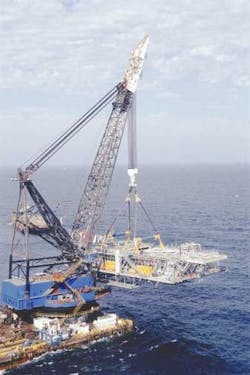Extensive decommissioning work ahead for aging GoM platforms
Jennifer Pallanich Hull
Gulf of Mexico Editor
With 1,080 structures in the Gulf of Mexico no longer productive and 4,000 aging units, decommiss-ioning specialists will have plenty of steel to dismantle. Various comp-anies have offered a number of solutions for the decommissioning process. Global Industries has a solution it thinks will appeal to the independents, who often have to dedicate a sizable portion of their balance sheet to meet surety bond requirements for field abandon-ment.
null
The company sees a steady stream of abandonment work ahead, said Eric Smith, vice president of strategic planning for Global Industries.
"These 4,000 remaining structures are significantly older than those that have been removed," Smith said. Global has taken out 173 structures since 1996. Even though many of the remaining structures are shallow by deepwater standards, the average depth has increased, requiring larger cranes and saturation diving. Many of the remaining structures are also heavier than the newer structures, Smith said, which is where the company's heavy lift capability will come in handy. The company said its fleet of construction barges and lift boats in the GoM matches the removal needs associated with the aging structures.
Global is primarily focused on the older platforms in the GoM's shallower waters.
"We're not going to be in the downhole abandonment business. We're in the structure and pipeline abandonment business," Smith said.
Calling the program a "potential surrogate for surety bonding," Smith said the proposition is one expected to pique the interest of the smaller independents who are required to post supplemental bonds to cover their abandonment liability. These companies may struggle more than the larger companies to find the necessary bonding capacity to meet requirements associated with field abandonment.
Under Global's plan, approved by the US Minerals Management Service, the operator distances itself from the non-mineral abandonment costs, while Global avoids liability for the operation of an outer continental shelf mineral lease, Smith said.
"We don't want downhole risk," he said.
He said the plan also provides certain accounting benefits for operators. Under required accounting practices, a company must begin recognizing the costs associated with removing long-lived assets immediately. If a functioning platform is sold to Global, Smith said, the asset – and its associated liability – comes off the operator's balance sheet and appears on Global's. Other benefits to the program, he said, include the freed-up bonding capacity and the innate efficiency associated with doing coordinated multiple abandonments rather than one at a time.
On the chance that a field outlasts or does not last to the end of the operator-Global plan agreement, he said, the contract between the two companies would feature a straddle or window feature.
Global is talking to operators, hoping to aggregate their abandonment liabilities for any particular year into a single season of work. The ideal, Smith said, is to schedule multiple abandonment projects and perform them sequentially.
Global plans to bring the deck-based materials to shore for recycling or scrapping. Some of the jackets will be placed in the reef program, as is current practice.
Smith said the program, if successful in the GoM, could be tailored to other countries where infrastructure is aging.


